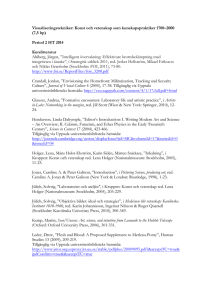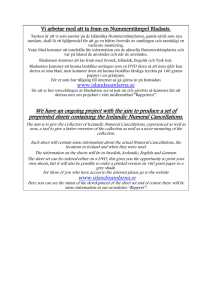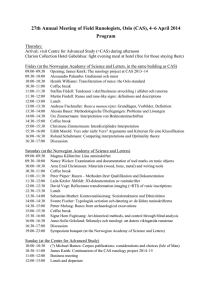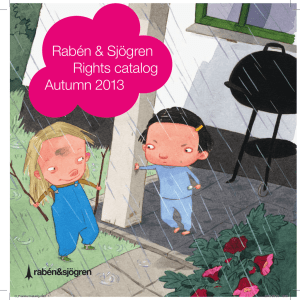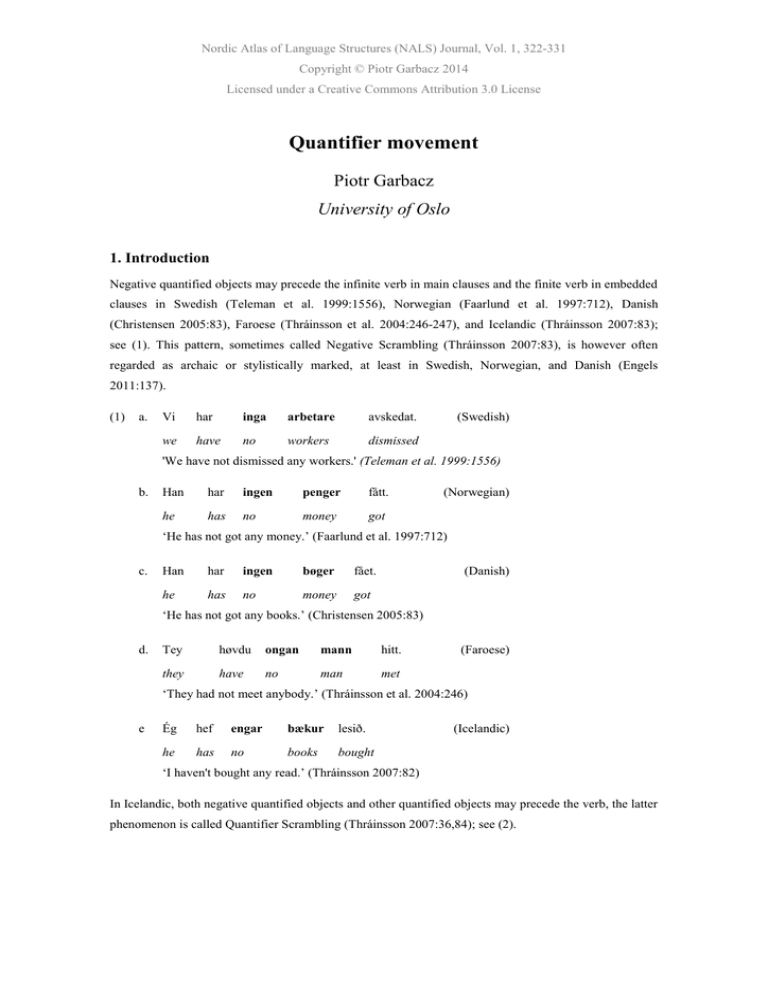
Nordic Atlas of Language Structures (NALS) Journal, Vol. 1, 322-331
Copyright © Piotr Garbacz 2014
Licensed under a Creative Commons Attribution 3.0 License
Quantifier movement
Piotr Garbacz
University of Oslo
1. Introduction
Negative quantified objects may precede the infinite verb in main clauses and the finite verb in embedded
clauses in Swedish (Teleman et al. 1999:1556), Norwegian (Faarlund et al. 1997:712), Danish
(Christensen 2005:83), Faroese (Thráinsson et al. 2004:246-247), and Icelandic (Thráinsson 2007:83);
see (1). This pattern, sometimes called Negative Scrambling (Thráinsson 2007:83), is however often
regarded as archaic or stylistically marked, at least in Swedish, Norwegian, and Danish (Engels
2011:137).
(1)
a.
Vi
har
inga
arbetare
avskedat.
we
have
no
workers
dismissed
(Swedish)
'We have not dismissed any workers.' (Teleman et al. 1999:1556)
b.
Han
har
ingen
penger
fått.
he
has
no
money
got
(Norwegian)
‘He has not got any money.’ (Faarlund et al. 1997:712)
c.
Han
har
ingen
bøger
fået.
he
has
no
money
got
(Danish)
‘He has not got any books.’ (Christensen 2005:83)
d.
Tey
høvdu
ongan
mann
hitt.
they
have
no
man
met
(Faroese)
‘They had not meet anybody.’ (Thráinsson et al. 2004:246)
e
Ég
hef
engar
bækur
lesið.
he
has
no
books
bought
(Icelandic)
‘I haven't bought any read.’ (Thráinsson 2007:82)
In Icelandic, both negative quantified objects and other quantified objects may precede the verb, the latter
phenomenon is called Quantifier Scrambling (Thráinsson 2007:36,84); see (2).
Garbacz
(2)
Quantifier movement
Jón
hefur
ýmsar
bækur
lesið.
Jón
has
various
books
read
NALS Journal
(Icelandic)
‘Jón has read various books.’ (Thráinsson 2007:84)
2. Results
2.1 Nordic Syntax Database (NSD)
In the Swedish and Norwegian parts of the ScanDiaSyn survey, placement of negative and quantified
object has been tested by means of the three sentences shown in (3) and their Swedish counterparts.
(3)
a.
Per
har
ingen
bøker
lest.
Per
has
no
books
read
(#928) (Norwegian)
'Per hasn't read any books.'
b.
Per
har
få
bøker
lest.
Per
has
few
books
read
(#929) (Norwegian)
'Per has read few books.'
c.
Per
har
mange
bøker
lest.
Per
has
many
books
read
(#930) (Norwegian)
'Per has read many books.'
In Norway, Negative Scrambling is rejected almost without exception (only in the village of Stamsund,
Lofoten, the informants judge the construction as marginally possible). In Sweden, Negative Scrambling
is judged as grammatical in a number of locations in the north, in Västerbotten (Burträsk) and Norrbotten
(Piteå, Kalix, Arjeplog), as well as in the west, in Halland (Våxtorp) and Västergötland (Floby and
Torsö). It further receives a medium score in a couple of places in the south, in Skåne (Bara and Löderup)
and in Småland (Torsås, Asby, Ankarsrum). In Finland, Negative Scrambling is always rejected. The
results are shown in Map 1.
323
Garbacz
Quantifier movement
NALS Journal
Map 1: Negative Scrambling in Norway, Sweden, and Finland.
(#928: Per har ingen bøker lest. ‘Per hasn’t read any books.’)
(White = high score, grey = medium score, black = low score).
Quantifier Scrambling with an object quantified by få 'few' is accepted as fully grammatical at one
location in Norway, in Oppland (Vestre Slidre) and at two locations in Sweden, in Norrbotten (Piteå and
Kalix). Moreover, it receives an intermediate score at a couple of locations in Western and Southeastern
Sweden, in Halland (Våxtorp), Västergötland (Floby), Örebro (Viby), and Blekinge (Torhamn). In
Finland, the construction is never accepted as fully grammatical. This is shown in Map 2.
324
Garbacz
Quantifier movement
NALS Journal
Map 2: Quantifier Scrambling with få 'few' in Norway, Sweden, and Finland.
(#929: Per har få bøker lest. ‘Per has read few books.’)
(White = high score, grey = medium score, black = low score).
Quantifier Scrambling with an object quantified by många/mange 'many' is in not judged as grammatical
in any of the locations where it was tested, se Map 3.
325
Garbacz
Quantifier movement
NALS Journal
Map 3: Quantifier Scrambling with månge/mange 'many'.
(#930: Per har mange bøker lest. ‘Per has read many books.’)
(White = high score, grey = medium score, black = low score).
In a couple of locations, there is variation between speakers as to whether #930 is grammatical or not.
This is especially the case in the Swedish provinces of Uppland, (Gräsö), Skåne (Löderup), Västmanland
(Skinnskatteberg), Västra Götaland (Orust and Torsö), Medelpad (Indal), Västernorrland (Torpshammar),
in the Finnish provinces of Österbotten (Närpes) and Nyland (Kyrkslätt) as well as in the Norwegian
location in Sogn og Fjordane (Jølster). In these places, either the younger informants (Jølster, Indal,
Orust, Skinnskattebergor, and Torphammar) or the older informants (Gräsö, Löderup, Närpes, Kyrkslätt,
Torsö) accept the test sentence #930. The locations are shown on Map 4.
326
Garbacz
Quantifier movement
NALS Journal
Map 4: Places where quantifier scrambling with månge/mange 'many' (#930) gets a high score (blue)
2.2 Nordic Dialect Corpus (NDC)
Negative objects preceding the main verb in situ are attested a couple of times in the NDC, see Map 5 and
the examples in (4) - (6) below.
327
Garbacz
Quantifier movement
NALS Journal
Map 5: Negative object preceding the infinite verb in the NDC (White = places of attestation).
(4)
vi
lå
jo
der
og
kunne
jo
ingenting
gøre
we
laid
ADV
there
and
could
ADV
nothing
do
‘...so we laid there and we could virtually do nothing.’ (vestjylland5)
(5)
så
jag
vill
egentligen
inget
göra
so
I
want-to
actually
nothing
do
(Swedish)
‘... so actually I don't want to do anything.’ (asby_om3)
(6)
vi
had-
kann
inngentinng
jære
me
da
we
had
can
nothing
do
with
it
‘We couldn't do anything with it.’ (joelster_03gm)
328
(Norwegian)
(Danish)
Garbacz
Quantifier movement
NALS Journal
3. Discussion
As Engels (2011: 149) states, there is considerable variation in Scandinavia as to whether Quantifier
Scrambling is present, and the variation is “not only a matter of style but it is also subject to dialectal and
inter-speaker variation (…)” (ibid.). This view can be confirmed in the present examination, however,
there seems to be no variation depending on age and sex.
Negative Scrambling is found in contemporary Swedish (7) and Danish (8), both in literary and
colloquial texts, although it is less frequent in Danish compared to Swedish. In Norwegian texts it is
almost completely absent, but still attested, for instance in the Oslo-korpuset av taggede norske tekster,
see (9).
(7)
Jag
har
inga
pengar
fått.
I
have
no
money
got
(Swedish)
‘I haven't got any money.’
(8)
Har
du
ingen
bøger
fået
ved
jordmoder?
have
you
no
books
got
with
midwife
(Danish)
‘Haven't you got any books from the midwife?’
(9)
Selv
hadde
han
ingen
hjelp
fått
i
sin
ungdom.
self
had
he
no
help
got
in
his
youth
(Norwegian)
‘Himself, he hadn't got any help when he was young.’
Quantifier Scrambling with the quantifier få 'few' is judged as possible by a handful of Swedish
informants, but it is not attested in other Swedish corpora like the Korp-corpus. As Engels (2012:138)
notes, the Scandinavian language (varieties) vary especially as to which constituent the negative object
can move past. The possibility of the word order Negative Object – Main Verb (in situ) is found in
Icelandic, Faroese, West Jutlandic, and in some varieties of Scandinavian (ibid.). There however varieties
that typically reject this word order, as e.g. Bokmål Norwegian, but examples of this word order can also
be found there, as well as in the Norwegian dialects.
329
Garbacz
Quantifier movement
NALS Journal
3.1 Historical development
Historically, Negative Scrambling and Quantifier Scrambling may be taken for reflexes of the older OVpattern that was present in Old Norse (Faarlund 2004:161) and in Old Swedish (Delsing 1999); cf. (10a)
and (10b) respectively.
(10)
a.
hefir
þú
nǫkkura
men
hitt
í
borginni?
have
you
some
men
found
in
town.DEF
(Norwegian)
'Did you meet anybody in the town?' (Faarlund 2004:161)
b.
guti
al
gutland
aigha
Guti
shall
Gotland
own
(Norwegian)
‘Guti shall own Gotland.’ (Delsing 1999:183)
The fact that Icelandic lost the OV-pattern much later than the other Scandinavian languages could also
explain quite well why Icelandic displays both Negative and Quantifier Scrambling, whereas the
Mainland Scandinavian languages and Faroese only display Negative Scrambling. OV was namely still
present in the 19th century Icelandic (Hróarsdóttir 2000), but it was lost in Swedish in the 17th century
(Delsing 1999) and in Norwegian already in the late 15th century (Sundquist 2002:146). Cf. the section
on postpredicative copulas.
References
Christensen, Ken Ramshøj. 2005. Interfaces: Negation - Syntax – Brain. Ph.D dissertation, Dept. of
Language, Literature, and Culture, Aarhus University: Aarhus.
Delsing, Lars-Olof. 1999. 'Från OV-ordföljd till VO-ordföljd: En språkförändring med förhinder,' Arkiv
för Nordisk Filologi 114, 151–232.
Faarlund Jan Terje, Svein Lie, and Kjell Ivar Vannebo. 1997. Norsk referansegrammatikk.
Universitetsforlaget: Oslo.
Faarlund, Jan Terje. 2004. The Syntax of Old Norse, Oxford University Press, New York.
Hróarsdóttir, Thorbjörg. 2000. Word Order Change in Icelandic. From OV to VO, John Benjamins:
Amsterdam & Philadelphia.
Sundquist, John Donald. 2002. Morphosyntactic Change in the History of the Mainland Scandinavian
Languages, unpublished Ph.D dissertation, Department of Germanic Studies, Indiana University.
Teleman, Ulf, Staffan Hellberg, and Erik Andersson. 1999. Svenska akademiens grammatik. Svenska
Akademien, Stockholm.
330
Garbacz
Quantifier movement
NALS Journal
Thráinsson, Höskuldur, Hjalmar Petersen, Jógvan í Lon Jacobsen, Zakaris Svabo Hansen. 2004. Faroese:
an overview and refrence grammar, Føroya Fróðskaparfelag: Tórshavn.
Thráinsson, Höskuldur. 2007. The Syntax of Icelandic, Cambridge University Press, New York.
Web sites:
Korp-corpus: http://spraakbanken.gu.se/korp/#hpp=25&sort=&stats_reduce=word
Nordic Atlas of Language Structures (NALS) Online: http://www.tekstlab.uio.no/nals
Nordic Dialect Corpus: http://www.tekstlab.uio.no/nota/scandiasyn/index.html
Nordic Syntax Database: http://www.tekstlab.uio.no/nota/scandiasyn/index.html
Oslo-korpuset av taggede norske tekster:
http://www.hf.uio.no/iln/tjenester/kunnskap/sprak/korpus/skriftsprakskorpus/oslo/index.html
331

